Sun 7 Jun 2009
Sunday’s Western Weekend Parade
Posted by DavidMitchell under agriculture, General News, Photography, Point Reyes Station
Comments Off on Sunday’s Western Weekend Parade
Sunday’s Western Weekend Parade packed the main street of Point Reyes Station, making it look like half the residents around Tomales Bay were either watching the parade or in it.

A Coast Guard color guard led the parade, followed by Marin County and Inverness fire engines. Several parade entries, including an inflatable boat from the Coast Guard base in Bodega Bay, had maritime themes.
 The good ship Mary Kay’s Revenge from Marshall. The Point Reyes Light on Thursday reported, “The boat is constructed largely of recycled sail cloth, plywood and pallets” and had been sitting “on Peggy Bannan’s porch in Reynold’s Cove” while awaiting the parade.
The good ship Mary Kay’s Revenge from Marshall. The Point Reyes Light on Thursday reported, “The boat is constructed largely of recycled sail cloth, plywood and pallets” and had been sitting “on Peggy Bannan’s porch in Reynold’s Cove” while awaiting the parade.

Parade Marshal Maidee Moore of Inverness received a ride from Dennis Luftig of Point Reyes Station. Maidee has long been active in civic affairs and is perhaps best known for decades of leading a program, Tomales Bay Waterdogs, which teaches children living around Tomales Bay how to swim.
 Western Weekend Queen Mindy Borello, 17, rode in a pickup-truck carriage during Sunday’s parade. Mindy won the queen contest by selling the most Western Weekend raffle tickets.
Western Weekend Queen Mindy Borello, 17, rode in a pickup-truck carriage during Sunday’s parade. Mindy won the queen contest by selling the most Western Weekend raffle tickets.
 Western Weekend Princess Rocio Gomez Together Rocio and Mindy sold more than $8,000 worth of raffle tickets.
Western Weekend Princess Rocio Gomez Together Rocio and Mindy sold more than $8,000 worth of raffle tickets.

The float was called “The Hula Hoopin’ Haley Grandkids,” and this grandkid was a pro.
 Three quarters of a century Inverness Garden Club’s entry each year includes numerous participants, a motorcycle with a sidecar, and a float festooned with flowers and greenery. This year the club is celebrating its 75th anniversary, hence the birthday cake. Among the club’s activities is maintaining flower beds in public places.
Three quarters of a century Inverness Garden Club’s entry each year includes numerous participants, a motorcycle with a sidecar, and a float festooned with flowers and greenery. This year the club is celebrating its 75th anniversary, hence the birthday cake. Among the club’s activities is maintaining flower beds in public places.
 Several kids on mini-motorcycles took part in the parade. This young biker may be new to the parade circuit, but he has already learned its protocol. To get the attention of other kids along the parade route carry a bag of candies and toss out handfuls. Works every time.
Several kids on mini-motorcycles took part in the parade. This young biker may be new to the parade circuit, but he has already learned its protocol. To get the attention of other kids along the parade route carry a bag of candies and toss out handfuls. Works every time.

Papermill Creek Children’s Corner (a preschool in Point Reyes Station) and Marin Head Start paraded together.

Planned Feralhood president Kathy Runnion of Nicasio, dressed as a cat and festooned with toy kittens, led her group’s parade entry. The group catches feral cats in Point Reyes Station and neuters or spays them.
Kathy finds homes for the kittens and as many of the adults as possible. A few adults cannot be domesticated and are returned to the street, but at least they are no longer reproducing. Not surprisingly, the number of feral kittens around town has dropped dramatically.
 West Marin School students dance a Paso Durangeneze. The group includes Alejandro Chavarria, 3rd grade; Graciela Avalos, Sarahisabel Barajaz, Stepanie Gonzalez, William Gonzalez, Shelby Hunt, Normar Isais, Bianca Lima, and Phoebe Marshall, 4th graders; and Armando Gonzalez, 5th grade. Their teacher is Dolores Gonzalez.
West Marin School students dance a Paso Durangeneze. The group includes Alejandro Chavarria, 3rd grade; Graciela Avalos, Sarahisabel Barajaz, Stepanie Gonzalez, William Gonzalez, Shelby Hunt, Normar Isais, Bianca Lima, and Phoebe Marshall, 4th graders; and Armando Gonzalez, 5th grade. Their teacher is Dolores Gonzalez.
 The Nave Patrola annually spoofs the Italian Army in World War I although it also borrows an “Il Duce” chant from World War II.
The Nave Patrola annually spoofs the Italian Army in World War I although it also borrows an “Il Duce” chant from World War II.
In the early 1970s, an official from the Italian Consulate in San Francisco complained to parade organizers, the West Marin Lions Club, that the patrol disparaged Italians, what with its seemingly confused marchers colliding with each other and going off in all directions.
Defenders of the patrol, however, replied that many of the members are of Italian descent. In addition, most folks here find Benito Mussolini, “the Duce of Fascism,” as he called himself, fair game for satire.

Bikini-clad dancers on an entry from Very Nice Firewood of Point Reyes Station waved placards that said, “Joe’s Knows How to Keep It Hot,” along with “Keep Warm & Toasty” and “Got Wood?”

A highlight of every Western Weekend Parade is the impressive Concord Blue Devils Drum and Bugle Corps, which participates in numerous parades each year. Based in Contra Costa County, the Blue Devils are a world-class drum corps, having won 12 Drum Corps International championships in the past 33 years.


 Thoroughly enjoying the livestock show were the dogs of Lisa Patsel, who owns Tree House bed-and-breakfast inn.
Thoroughly enjoying the livestock show were the dogs of Lisa Patsel, who owns Tree House bed-and-breakfast inn.
 Michelle McClure took first place in senior showmanship for Holstein cows, and Nathan Hemett took second.
Michelle McClure took first place in senior showmanship for Holstein cows, and Nathan Hemett took second.
 Freddie Genazzi’s red slider named Ozzie took first place in the turtle competition. Although his sister wasn’t present, her turtle, whom the judge dubbed Harriet, took second.
Freddie Genazzi’s red slider named Ozzie took first place in the turtle competition. Although his sister wasn’t present, her turtle, whom the judge dubbed Harriet, took second.
 Judges Ellie Genazzi and Terry Gray compare notes during the Western Weekend Fair’s dog show.
Judges Ellie Genazzi and Terry Gray compare notes during the Western Weekend Fair’s dog show.
 While the obstacle course confused all the dogs that went on it, this Dumpster behind the Dance Palace confused virtually all the humans who went to use it.
While the obstacle course confused all the dogs that went on it, this Dumpster behind the Dance Palace confused virtually all the humans who went to use it. While driving on Novato Boulevard between Hicks Valley and Stafford Lake, Anika was startled to see a purple couch abandoned on the shoulder of the road. (Since then I’ve heard from others who also saw it and were likewise surprised.)
While driving on Novato Boulevard between Hicks Valley and Stafford Lake, Anika was startled to see a purple couch abandoned on the shoulder of the road. (Since then I’ve heard from others who also saw it and were likewise surprised.)




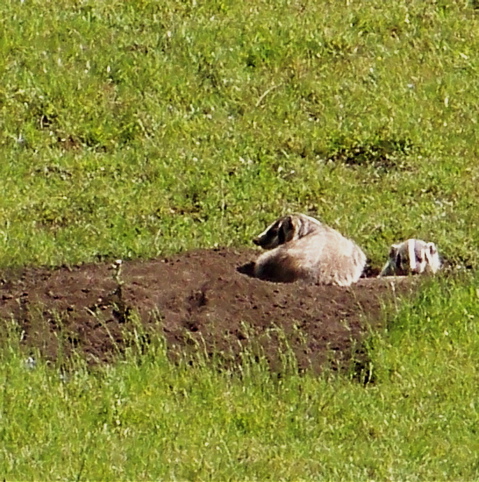
 I’ve see badgers for sale as food in a Guangzhou, China, marketplace. And badgers were once a staple of the Native American, as well as colonial, diet. Even today they’re commonly eaten in France, Russia, and other European countries, as well as China.
I’ve see badgers for sale as food in a Guangzhou, China, marketplace. And badgers were once a staple of the Native American, as well as colonial, diet. Even today they’re commonly eaten in France, Russia, and other European countries, as well as China.
 Ratty, as he is called in The Wind in the Willows, showed up on my deck Tuesday to take a drink from the birdbath and eat whatever birdseed he could find.
Ratty, as he is called in The Wind in the Willows, showed up on my deck Tuesday to take a drink from the birdbath and eat whatever birdseed he could find.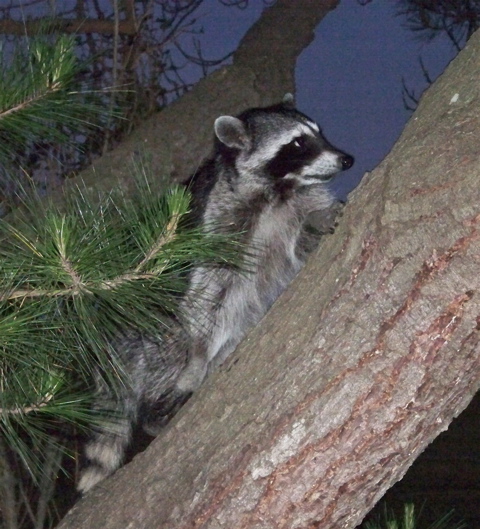
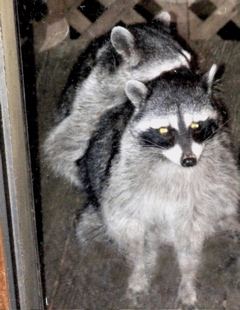 In Spring a young raccoon’s fancy lightly turns to thoughts of love, to paraphrase Tennyson.
In Spring a young raccoon’s fancy lightly turns to thoughts of love, to paraphrase Tennyson.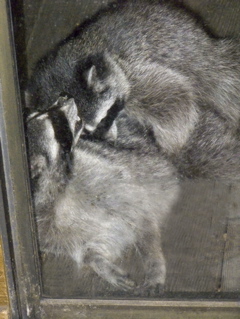 Even more of a surprise was that they sometimes appeared to be actually making love.
Even more of a surprise was that they sometimes appeared to be actually making love.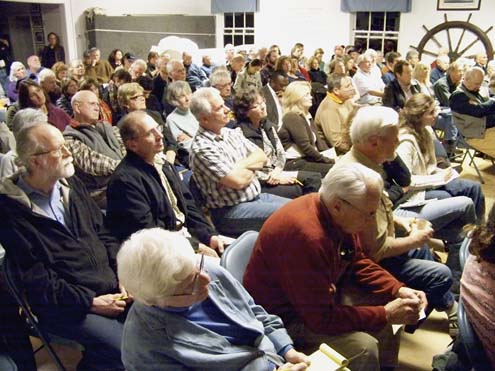


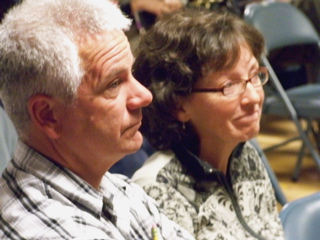 Closely following Friday’s discussion are oyster company owners Kevin and Nancy Lunny.
Closely following Friday’s discussion are oyster company owners Kevin and Nancy Lunny.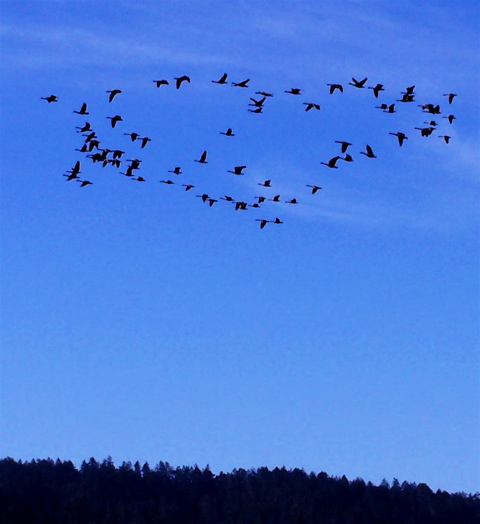


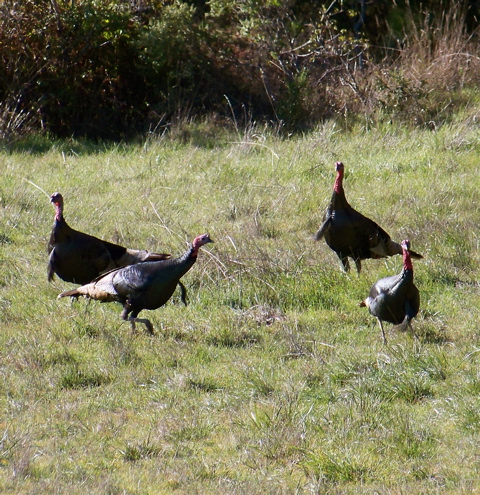

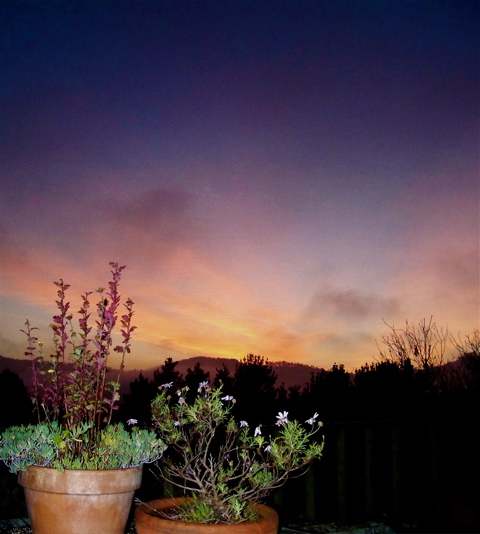
 Not long after midnight this morning, I was sitting by my woodstove looking into the flames when I heard a coyote howling in the neighboring horse pasture (right), which is owned by the Giacomini family.
Not long after midnight this morning, I was sitting by my woodstove looking into the flames when I heard a coyote howling in the neighboring horse pasture (right), which is owned by the Giacomini family. Soon all three coyotes were howling at once. They finally stopped, but I stayed outside, straining to hear more in the blackness of a moonless midnight.
Soon all three coyotes were howling at once. They finally stopped, but I stayed outside, straining to hear more in the blackness of a moonless midnight. In my case, however, the howling was a happy reminder that here in the small towns of West Marin, the Old West lives on. The coyotes howl, and the wind blows free.
In my case, however, the howling was a happy reminder that here in the small towns of West Marin, the Old West lives on. The coyotes howl, and the wind blows free. Two weeks ago, as was reported here, I had been thrilled to see and photograph a bobcat hunting near a car parked at my house. This time, the bobcat was even closer.
Two weeks ago, as was reported here, I had been thrilled to see and photograph a bobcat hunting near a car parked at my house. This time, the bobcat was even closer.
 The cat was hunting gophers, and I while I watched, it pounced and caught one. With the gopher dangling from its mouth, the bobcat then ran uphill to eat its meal under a clump of coyote brush. Later today, I twice again spotted the bobcat nearby.
The cat was hunting gophers, and I while I watched, it pounced and caught one. With the gopher dangling from its mouth, the bobcat then ran uphill to eat its meal under a clump of coyote brush. Later today, I twice again spotted the bobcat nearby. Three or four mornings ago, I had likewise looked out a kitchen window and spotted a mottled cat (at left) with a bobbed tail hunting near my woodpile.
Three or four mornings ago, I had likewise looked out a kitchen window and spotted a mottled cat (at left) with a bobbed tail hunting near my woodpile. Soon the cat walked over to my woodpile and sat at the edge of the tarpaulin that covers it.
Soon the cat walked over to my woodpile and sat at the edge of the tarpaulin that covers it.